| Fokker 100 | |
|---|---|
| Alliance Airlines Fokker 100 (F-28-0100) | |
| Role | Narrow-body Regional jet airliner |
| National origin | Netherlands |
| Manufacturer | Fokker |
| First flight | 30 November 1986 |
| Introduction | April 25, 1988 with Swissair |
| Status | In service |
| Primary users | Austrian Airlines Alliance Airlines Avianca Brazil Iran Air |
| Produced | 1986-1997 |
| Number built | 283 |
| Developed from | Fokker F28 Fellowship |
| Variants | Fokker 70 |
The Fokker 100 is a medium-size twin-turbofan airliner from Fokker. Low operational costs and scant competition in the 100-seat short-range class led to strong sales when it was introduced in the late 1980s, but sales fell as competition increased. Production ended in 1997 with 283 airframes delivered. In July 2012, 156 Fokker 100 aircraft remained in airline service with 30 airlines around the world.[1] It was the largest jet airliner built by Fokker before its bankruptcy in 1997.
Design and development[]
The Fokker F28 Mk 0100 program was announced in 1983 as an updated replacement for Fokker's popular, but superseded F28 Fellowship design. Marketed as the Fokker 1000 the design was based on the original F28 but features modern avionics, new generation Rolls-Royce Tay turbofan engines and a redesigned wing. However the most noticeable difference was the longer fuselage, which increased seating by 65% from 65 in the original F28 series to a maximum of 107 in a three-by-two single-class arrangement. The new wing is claimed by Fokker to be 30% more efficient in cruise, while still keeping the simplicity of a fixed leading edge. The cockpit was updated with a Rockwell Collins DU-1000 EFIS. Like the Fokker Fellowship, the Fokker 100 features twin rear fuselage-mounted engines and a T-tail, similar to that of the Douglas DC-9 family. The Fokker 100 does not have eyebrow windows above the main cockpit windows as on the Fokker F28.
Two prototypes were built - the first, PH-MKH, flew for the first time on 30 November 1986, and the second, PH-MKC, followed on 25 February 1987. The type certificate was awarded in November 1987. The first deliveries of the Tay 620-15 powered versions started to Swissair in February 1988. American Airlines (75 aircraft ordered), TAM Transportes Aéreos Regionais (now TAM Airlines) (50 aircraft) and USAir (40 aircraft) were major customers of the Fokker 100 and their aircraft were powered by the more powerful Tay 650-15.
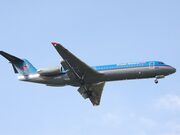
British Midland Airways Fokker 100
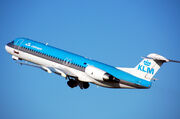
KLM Cityhopper Fokker 100 (old colors)
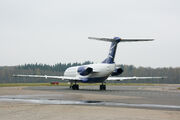
Montenegro Airlines Fokker 100 at Domodedovo Airport
Skywest Airlines Fokker 100 side view, during maintenance at Perth Airport
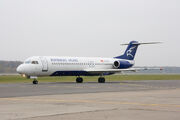
Montenegro Airlines Fokker 100
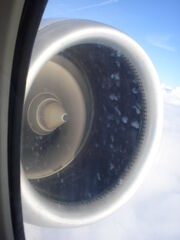
Rear seat engine view of a KLM Cityhopper Fokker 100
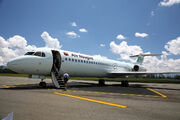
An Air Niugini Fokker 100 (P2-ANH) parked at Mt. Hagen's Kagamuga Airport, Papua New Guinea.

An Iran Air Fokker 100 at Shiraz International Airport, Iran. (2007)
Operational history[]
By 1991, Fokker had produced 70 units and had orders for more than 230. An extended-range version with additional fuel tanks in the wings was introduced in 1993, and a quick-change passenger/freighter version in 1994, the 100QC. A shorter version was introduced in 1993 as a replacement for the earlier F28, known as the Fokker 70, which removed 4.70 m (15.42 ft) of the fuselage and reduced seating to 80. Studies on the 130 seat Fokker 130 and the Fokker 100QC (freighter) did not reach further stages of development. A Fokker 100EJ (Executive Jet) was introduced in 2003 as a conversion from used Fokker 100 aircraft.
Although the design was a success in the marketplace, Fokker continued to lose money due to mismanagement. Eventually their parent company, Daimler Benz Aerospace, shut them down. Fokker collapsed in 1996 and wound up production in early 1997. There had been some discussion about the company being purchased by Bombardier, but the plans fell through.
An Amsterdam-based group, Rekkof Restart (Rekkof is Fokker spelled backwards) negotiated to re-open the Fokker 70 and 100 lines in 1999, but the deal never completed. Stork B.V. acquired the maintenance business for the aircraft and operated it under the name "Fokker Aviation".[2]
Like any number of designs, the 70/100 was being increasingly squeezed from below by stretched versions of the Bombardier and Embraer regional jets, which also killed off plans for the Fairchild Dornier 528JET/728JET/928JET and an unnamed design from ATR. A proposed stretch version called the Fokker 130 was never built.[2]
From 2014 the French DGA Essais en Vol used a Fokker 100 as a flying test bed. It replaced former Dassault Mystère XX's business jet. This Fokker 100 is a former Régional's aircraft. It's called ABE-NG, for Avion Banc-d'Essais de Nouvelle Génération.[3]
Operators[]
As of March 2014, 160 aircraft are still in operational use with airlines.[4][5]
- Air Niugini (7)
- Air Panama (2)
- Alliance Airlines (17)
- Austrian Airlines (15)
- Avianca Brasil (13)
- Bek Air (5)
- Compagnie Africaine d'Aviation (1)
- Carpatair (2)
- Caspiy (2)
- Greenland Express (2) (Operated by Denim Air)
- Helvetic Airways (6)
- Iran Air (12)
- Iran Aseman Airlines (16)
- Kish Air (3)
- Mjet Aviation (3)
- Moldavian Airlines (1)
- Network Aviation (12)
- Montenegro Airlines (5)
- Naft Airlines (4)
- Pelita Air (10)
- PGA Portugália Airlines (6)
- Qeshm Airlines (4)
- Government of Ivory Coast (1)
- Skippers Aviation(Australia) (1)
- Virgin Australia Regional Airlines (11)
- Trade Air (3)
- Transwisata Air (1)
Former operators[]
- Aero Mongolia
- Air Berlin
- Air Europe
- Air Express
- Air France
- Air Gabon
- Air Greece
- Air Inter
- Air Littoral
- Air UK
- KLMuk
- AirQuarius Aviation
- American Airlines
- Avianca
- Blue Line
- BMI/British Midland
- Brit Air
- Canadian Airlines (as Canadian Régional)]]
- CCM Airlines
- Contact Air
- Cosmic Air
- Croatia Airlines
- EUjet
- Flight West Airlines
- Germania
- Girjet
- Intair
- Inter Airlines
- Iran Air Transport
- Jetsgo
- Kish Air
- KLM Cityhopper
- Korean Air
- Kostar Airlines
- Mandarin Airlines
- Merpati Nusantara Airlines
- Mexicana
- Midway Airlines
- Moldavian Airlines
- OLT Jetair
- Palair Macedonian Airlines
- Régional
- Royal Brunei Airlines
- Royal Swazi National Airlines
- SAM
- Sempati Air
- Slovak Airlines
- Sol del Paraguay
- Swissair
- TABA
- TAM Airlines
- TAM Airlines (Paraguay)
- TAT European Airlines
- Uair
- US Airways (formerly USAir)
- Yeongnam Air
Accidents and incidents[]
- 5 March 1993 – Palair Macedonian Airlines Flight 301, a Fokker 100 (PH-KXL) crashed shortly after takeoff from Skopje Airport on its way to Zurich Airport, killing 83 of 97 passengers and crew on board.[6]
- 31 October 1996 – a TAM Airlines Fokker 100 operating flight 402 crashed next to São Paulo-Congonhas Airport in Brazil, killing 99 people, including everyone on board plus four people on the ground.[7][8]
- 9 July 1997 – a TAM Airlines Fokker 100 registration PT-WHK operating flight 283 en route from São José dos Campos to São Paulo-Congonhas was climbing after takeoff from São José dos Campos when a bomb exploded in the rear part of the passenger cabin. The uncontrolled decompression blew one passenger out of the aircraft. The aircraft made a successful emergency landing in São Paulo, despite the hole in the fuselage.[9]
- 7 November 1999 – Air Dolomiti Flight 2708, a Fokker 100 flying from Venice Marco Polo Airport with 44 on board, suffered main gear failure while approaching Barcelona International Airport and landed safely on a foam carpet.[10]
- 23 May 2001 – The right main landing gear of an American Airlines Fokker 100, registration number N1419D, operating as AA Flight 1107, collapsed upon landing on Runway 17C at Dallas/Fort Worth International Airport after a scheduled flight from Charlotte/Douglas International Airport. The pilot was able to maintain directional control and bring the aircraft to a stop on the runway. The incident was attributed to metal fatigue caused by a manufacturing flaw in the right main gear's outer cylinder; there were no serious injuries to the 88 passengers or 4 crew, but the aircraft was written off.[11][12]
- 15 September 2001 – a TAM Airlines Fokker 100 registration PT-MRN operating the charter flight 9755, flying from Recife to Campinas-Viracopos, following an uncontained engine failure en route to Campinas had 3 cabin windows shattered by fragments of the engine and made an emergency landing at Belo Horizonte-Confins. One passenger was sucked out partly and held by another passenger until the aircraft landed. The passenger did not survive.[13][14]
- 8 June 2002 – a TAM Airlines Fokker 100 en route from São Paulo to Marechal Rondon International Airport Cuiabá made a successful emergency landing in a farm near Birigui due to fuel exhaustion caused by a leak. All 5 crew and 24 passengers survived without injuries. Unfortunately a cow was run over and killed by the airplane.[15]
- 25 January 2007 – Air France Flight 7775 from Pau to Paris crashed shortly after take-off. All 54 passengers and crew escaped from the aircraft, although one person on the ground was killed .[16] An investigation by the BEA revealed that the cause of the accident was ice on the wings of the aircraft involved.[17]
- 2 February 2008 – an Austrian Airlines Fokker 100 made an emergency landing at Leeds Bradford International Airport in the UK, after the right engine was reported idle. The pilots landed safely, and there were no injuries among the 103 passengers and crew on board.[18]
- 12 August 2009 – the wheel on an Aseman Airlines Fokker 100 exploded and caught fire as the aircraft made a hard landing in the city of Isfahan.
- 14 September 2009 – Contact Air Flight 288 from Berlin Tegel was forced to make an emergency landing at Stuttgart Airport, Germany. None of the passengers, including well-known German politician Franz Müntefering, were seriously injured.
- 18 November 2009 – Iran Air Fokker 100 EP-CFO suffered a landing gear malfunction on takeoff from Isfahan International Airport. The aircraft was on a flight to Mehrabad Airport, Tehran when the undercarriage failed to retract. The aircraft landed at Isfahan, but was substantially damaged when the left main gear collapsed.[19]
- 3 December 2009 – Merpati Nusantara Airlines Fokker 100 PK-MJD made an emergency landing at El Tari Airport, Kupang when the left main gear failed to extend. There were no injuries among the passengers and crew.[20]
- 15 January 2010 – Iran Air Fokker 100 EP-IDA, operating Flight 223 was substantially damaged when the nose gear collapsed after landing at Isfahan International Airport.[21]
- 11 February 2010 – Click Mexicana Fokker 100 XA-SHJ, operating flight CBE7222 was forced to land on its belly due to a presumed mechanical failure of the landing gear; it was routed to make an emergency landing at Aeropuerto Internacional de Monterrey where the aircraft overran the runway. None of the passengers were seriously injured.[22]
- 25 August 2010 – Iran Aseman Airlines Fokker 100, operating as Flight 773, overran the runway on landing at Tabriz International Airport in bad weather. The aircraft was substantially damaged.[23]
- 25 December 2012 – Air Bagan Flight 11 XY-AGC crash-landed through trees which removed the wings 3km from Heho Airport, killing one on board, one on the ground and injuring 11.[24]
- 28 March 2014 – Avianca Brazil Fokker 100 MK28, operating as flight 6393 was forced to land on its belly at Brasília International Airport due to a presumed mechanical failure of the landing gear. 44 passengers and 5 crew members were onboard. Everyone survived the event.[25]
- 10 May 2014 – Iran Aseman Airlines Fokker 100 operating as flight 8053 made an emergency landing at Zahedan Airport when the rear wheels of the plane failed to lower. The pilot was required to circle the field for about an hour to consume excess fuel (in case of fire), before attempting the landing. Upon touchdown, the front tire exploded, and the aircraft was transitioned onto the grassy margins of the runway, without severe injuries.[25]
Aircraft on display[]
- Ex-KLM Cityhopper PH-OFA Preserved at Lelystad Airport at the Aviodrome
- Ex-KLM Cityhopper PH-OFE Preserved at Amsterdam Airport Schiphol on visitor's terrace
- Ex-TAM Linhas Aéreas PT-MRL Preserved at QSC in retro scheme, at TAM's Museum
- Unknown Fokker 100 preserved in Breda on the roof of Stolwerk Metaal BV
Specifications[]
| Fokker 100 Tay 620 |
Fokker 100 Tay 650 | |
|---|---|---|
| Cockpit crew | Two | |
| Seating capacity | 122 (1-class, maximum) 107 (1-class, typical) 97 (2-class, typical) | |
| Seat pitch | 29 in (74 cm) (1-class, maximum) 32 in (81 cm) (1-class, typical) 36 in (91 cm) & 32 in (81 cm) (2-class, typical) | |
| Length | 35.53 metres (116 ft 7 in) | |
| Wingspan | 28.08 metres (92 ft 2 in) | |
| Wing area | 93.5 square metres (1,006 sq ft) | |
| Height | 8.50 metres (27 ft 11 in) | |
| Fuselage diameter | 3.30 m (10 ft 10 in) | |
| Cabin width | 3.10 m (10 ft 2 in) | |
| Cabin height | 2.01 m (6 ft 7 in) | |
| Typical empty weight | 24,375 kilograms (53,738 lb) | 24,541 kilograms (54,104 lb) |
| Maximum take-off weight | 43,090 kilograms (95,000 lb) | 45,810 kilograms (100,990 lb) |
| Maximum payload weight | 11,242 kilograms (24,784 lb) | 11,993 kilograms (26,440 lb) |
| Max. cruising speed | 845 km/h (525 mph, 456 kn), Mach 0.77 | |
| Range fully loaded | 1,323 nautical miles (2,450 km; 1,522 mi) | 1,710 nautical miles (3,170 km; 1,970 mi) |
| Take off run at MTOW | 4,988 feet (1,520 m) | 5,319 feet (1,621 m) |
| Fuel capacity | 13,365 L (2,940 imp gal; 3,531 US gal) | |
| Service ceiling | 35,000 ft (11,000 m) | |
| Powerplants (2x) | Rolls-Royce Tay Mk 620-15 | Rolls-Royce Tay Mk 650-15 |
| Engine thrust | 13,850 lbf (61.6 kN) | 15,100 lbf (67.2 kN) |
- Notes: Data are provided for reference only. Tay 620=Rolls-Royce Tay Mk 62015 and Tay 650=Rolls-Royce Tay Mk 65015
- Sources: airliners.net,[26] aer.ita.br[27]
See also[]
- Fokker 70
- Airbus A318
- Antonov An-158
- British Aerospace 146
- Boeing 717
- Bombardier CRJ1000
- Embraer E-190/195
- Fairchild Dornier 728 family
- Sukhoi Superjet 100
- Tupolev Tu-334
- Yakovlev Yak-42D
- List of civil aircraft
References[]
- Notes
- ↑ Flight International World Airliner Census 2012
- ↑ 2.0 2.1 "History of Fokker." undinguniverse.com. Retrieved: 17 August 2011.
- ↑ http://www.aerobuzz.fr/spip.php?article4938
- ↑ "http://www.ch-aviation.ch/aircraft.php?&search=search&operator=AND&ac_ac=F100&start=30
- ↑ http://www.fokker-aircraft.info/fleetlist.htm
- ↑ "ASN Aircraft accident Fokker 100 PH-KXL Skopje." Aviation Safety Network. Retrieved: 13 April 2008.
- ↑ "Accident description PT-MRK." Aviation Safety Network. Retrieved: 17 August 2011.
- ↑ Germano da Silva, Carlos Ari César (2008). "Vinte e quatro segundos" (in Portuguese). O rastro da bruxa: história da aviação comercial brasileira no século XX através dos seus acidentes 1928-1996 (2 ed.). Porto Alegre: EDIPUCRS. pp. 376–381. ISBN 978-85-7430-760-2.
- ↑ "Accident description PT-WHK." Aviation Safety Network. Retrieved: 17 August 2011.
- ↑ "ASN Aircraft accident Fokker 100 I-ALPL Barcelona Airport (BCN)." Aviation Safety Network. Retrieved: 17 August 2011.
- ↑ "NTSB Brief of Accident FTW01FA127". National Transportation Safety Board. http://dms.ntsb.gov/aviation/AccidentReports/ewctm0jxmuyeq15524ctkfzq1/U05312012120000.pdf. Retrieved 2012-05-31.
- ↑ "ASN Accident Description". Aviation Safety Network. http://aviation-safety.net/database/record.php?id=20010523-0. Retrieved 2011-05-31.
- ↑ "Accident description PT-MRN." Aviation Safety Network. Retrieved: 17 August 2011.
- ↑ Marra, Lívia. "Avião da TAM acidentado em Minas havia sido revisado no mês passado" (in Portuguese.] Folha Online, 16 September 2001. Retrieved: 23 May 2011.
- ↑ "Accident description" Estadão Retrieved: 30 August 2002.
- ↑ "Picture: Truck driver killed as Air France Régional Fokker 100 hits vehicle during overrun in Pau." Flight Global. Retrieved: 2 January 2009.
- ↑ "Icing led to Air France Fokker takeoff crash: investigators." Flight Global. Retrieved: 2 January 2009.
- ↑ BBC News
- ↑ "Accident description: Fokker 100 EP-CFO." Aviation Safety Network. Retrieved: 17 August 2011.
- ↑ "Merpati Air Plane Passengers Unharmed In Emergency Landing." Bernama. Retrieved: 4 December 2009.
- ↑ "Accident: Iran Air F100 at Isfahan on Jan 15th 2010, nose gear collapse on landing." Aviation Herald. Retrieved: 17 January 2010.
- ↑ "Avión aterriza de emergencia en Monterrey." eluniversal.com, 11 February 2010.
- ↑ "Plane Skids off Runway in Northwestern Iran." Fars News Agency. Retrieved: 27 August 2010.
- ↑ "Airliner makes emergency landing on Myanmar road" AP. Retrieved: 25 December 2012.
- ↑ 25.0 25.1 "Avião da Avianca faz pouso de emergência em Brasília" "UOL" Retrieved: 28 January 2014. Cite error: Invalid
<ref>tag; name "UOL" defined multiple times with different content - ↑ "The Fokker 100." airliners.net. Retrieved: 17 August 2011.
- ↑ Fokker 100 Specifications aer.ita.br. Retrieved: 29 January 2012.
- Bibliography
- Taylor, Michael J. H. 'Brassey's World Aircraft & Systems Directory. London: Brassey's, 1996. ISBN 1-85753-198-1.
External links[]
| Wikimedia Commons has media related to Fokker F100. |
- Fokker 100 page on manufacturer's site
- Future100 Executive Jet and operators pages on FokkerServices.com
- Rekkof Project
- Rekkof : Fokker 100NG
- Fokker 100 info
The original article can be found at Fokker 100 and the edit history here.
| |||||||||||||||||||||||||||||||||||||||||||||||||||||||||
